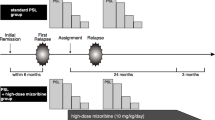Abstract
This study was done to determine the efficacy of oral high dose methylprednisolone (HDMP) therapy in the treatment of childhood nephrotic syndrome (NS). Fifteen patients were enrolled in the study. Patients were arbitrarily divided into two groups. Group I received prednisolone (daily 60 mg/m2 for 4 weeks, 45, 30, 20, 10, 5 mg/m2 on alternate days for 4 weeks) and group II received HDMP (30 mg/kg/d for 3 days, 20 mg/kg/d for 4 days, 10 mg/kg/for a week, before 9 am, orally). The patients were followed-up for a duration of 38.0±5.5 months (range 24–68 months) in group I and 42.1±5.5 months (range 16–72 months) in group II. No significant difference was obtained in the duration of remission between both groups (p>0.05), while HDMP induced early remission than prednisolone (p<0.05). The mean relapse rate was 0.8/year in group I and 0.8/year in group II (p>0.05). Although, the number of the patients were limited in the study it can be recommended that patients with NS can be treated with oral HDMP therapy as an alternative to standard oral prednisolone therapy.
Similar content being viewed by others
References
Churg J, Habib R, White RHR. Pathology of the nephrotic syndrome in children. A report of the International Study of Kidney Disease in Children.Lancet 1970; 1: 1299–1302.
White RHR, Glaskow EF, Mills RJ. Clinicopathological study of nephrotic syndrome in childhood.Lancet 1970; 1: 1353–1359.
Barnett HC, Mc. Namara H, Mc Crory W.et al. Effect of ACTH and cortisone on the nephrotic syndrome.Am J Dis Child 1950; 80: 519–520.
Schnaper HW. The immunesystem in minimal change nephrotic syndrome.Pediatr Nephrol 1989; 3: 101–110.
Shalhoub RJ. Pathogenesis of lipoid nephrosis—a disorder of T cell function.Lancet 1974; II: 556–560.
Barnett HL., Schoeneman M, Bernstein J.et al. Minimal change nephrotic syndrome In: Edelman CM (ed).Pediatric Kidney Disease. Little Brown, Boston, 1978; pp. 695–711.
Young CK, Wong KL, Ng WL. Intravenous methylprednisolone pulse therapy in minimal change nephrotic syndrome.Aust N Z J Med 1983; 13: 349–351.
Baylis EM, Williams IA, English Jet al. High dose intravenous methylprednisolone pulse therapy in patients with rheumatoid disease.Eur J Clin Pharmacol 1982; 21: 385–388.
Author information
Authors and Affiliations
Rights and permissions
About this article
Cite this article
Mocan, H., Erduran, E. & Karagüzel, G. High dose methylprednisolone therapy in nephrotic syndrome. Indian J Pediatr 66, 171–174 (1999). https://doi.org/10.1007/BF02761198
Issue Date:
DOI: https://doi.org/10.1007/BF02761198




